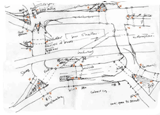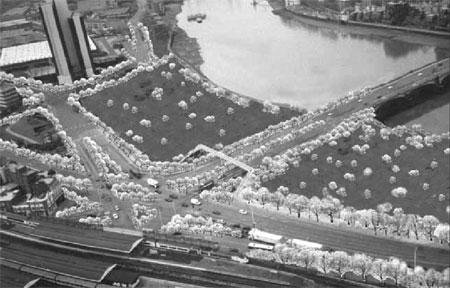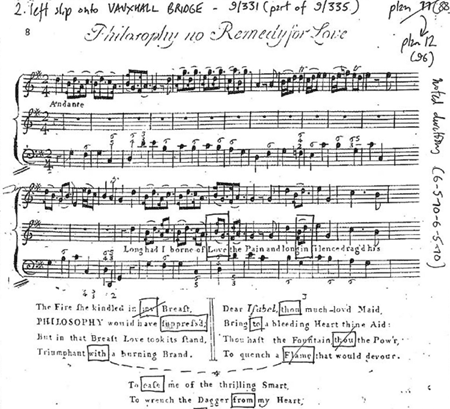Extracts from ‘The Social Ideology of the Motorcar’ by Andre Gorz
THE WORST THING about cars is that they are like castles or villas by the sea: luxury goods invented for the exclusive pleasure of a very rich minority, and which in conception and nature were never intended for the people. Unlike the vacuum cleaner, the radio, or the bicycle, which retain their use value when everyone has one, the car, like a villa by the sea, is only desirable and useful insofar as the masses don't have one. That is how in both conception and original purpose the car is a luxury good. And the essence of luxury is that it cannot be democratised. If everyone can have luxury, no one gets any advantages from it. On the contrary, everyone diddles, cheats, and frustrates everyone else, and is diddled, cheated, and frustrated in return.
This is pretty much common knowledge in the case of the seaside villas. No politico has yet dared to claim that to democratise the right to vacation would mean a villa with private beach for every family. To give everyone his or her share would be to cut up the beaches in such little strips - or to squeeze the villas so tightly together that their use value would be nil. In short, democratisation of access to the beaches point to only one solution - the collectivist one. And this solution is necessarily at war with the luxury of the private beach, which is a privilege that a small minority takes as their right at the expense of all.
Like the beach house, doesn't a car occupy scarce space? Doesn't it deprive the others who use the roads (pedestrians, cyclists, streetcar and bus drivers)? Doesn't it lose its use value when everyone uses his or her own? And yet there are plenty of politicians who insist that every family has the right to at least one car and that it's up to the "government" to make it possible for everyone to park conveniently, drive easily in the city, and go on holiday at the same time as everyone else, going 70 mph on the roads to vacation spots.
This means of transportation at first seemed unattainable to the masses. There was no comparison between the motorcar and the others: the cart, the train, the bicycle, or the horse-car. Exceptional beings went out in self-propelled vehicles that weighed at least a ton and whose extremely complicated mechanical organs were as mysterious as they were hidden from view. For one important aspect of the automobile myth is that for the first time people were riding in private vehicles whose operating mechanisms were completely unknown to them and whose maintenance and feeding they had to entrust to specialists. Here is the paradox of the automobile: it appears to confer on its owners limitless freedom, allowing them to travel when and where they choose at a speed equal to or greater than that of the train. But actually, this seeming independence has for its underside a radical dependency. Unlike all previous owners of a means of locomotion, the motorist's relationship to his or her vehicle was to be that of user and consumer and not owner and master. This vehicle, would oblige the owner to consume and use a host of commercial services and industrial products that could only be provided by some third party. The oil magnates were the first to perceive the prize that could be extracted from the wide distribution of the motorcar. The dream of every capitalist was about to come true. Everyone was going to depend for their daily needs on a commodity that a single industry held as a monopoly.
Maybe you are saying, "But at least in this way you can escape the hell of the city once the workday is over." There we are, now we know: "the city," the great city which for generations was considered a marvel, the only place worth living, is now considered to be a "hell." Everyone wants to escape from it, to live in the country. Why this reversal? For only one reason. The car has made the big city uninhabitable. It has made it stinking, noisy, suffocating, dusty, so congested that nobody wants to go out in the evening anymore. Thus, since cars have killed the city, we need faster cars to escape on superhighways to suburbs that are even farther away. What an impeccable circular argument: give us more cars so that we can escape the destruction caused by cars. Capitalist industry has thus won the game: the superfluous has become necessary.
"People," writes Illich, "will break the chains of overpowering transportation when they come once again to love as their own territory their own particular beat, and to dread getting too far away from it." But in order to love "one's territory" it must first of all be made liveable, and not trafficable. The neighbourhood or community must once again become a microcosm shaped by and for all human activities, where people can work, live, relax, learn, communicate, and knock about, and which they manage together as the place of their life in common. When someone asked him how people would spend their time after the revolution, when capitalist wastefulness had been done away with, Marcuse answered, "We will tear down the big cities and build new ones. That will keep us busy for a while."
These new cities might be federations of communities (or neighbourhoods) surrounded by green belts whose citizens - and especially the schoolchildren - will spend several hours a week growing the fresh produce they need. To get around everyday they would be able to use all kinds of transportation adapted to a medium-sized town: municipal bicycles, trolleys or trolley-buses, electric taxis without drivers. For longer trips into the country, as well as for guests, a pool of communal automobiles would be available in neighbourhood garages. The car would no longer be a necessity. Everything will have changed: the world, life, people. And this will not have come about all by itself.
Meanwhile, what is to be done to get there? Above all, never make transportation an issue by itself. Always connect it to the problem of the city, of the social division of labour, and to the way this compartmentalises the many dimensions of life. One place for work, another for "living," a third for shopping, a fourth for learning, a fifth for entertainment. The way our space is arranged carries on the disintegration of people that begins with the division of labour in the factory. It cuts a person into slices, it cuts our time, our life, into separate slices so that in each one you are a passive consumer at the mercy of the merchants, so that it never occurs to you that work, culture, communication, pleasure, satisfaction of needs, and personal life can and should be one and the same thing: a unified life, sustained by the social fabric of the community.
Le Sauvage September-October 1973




